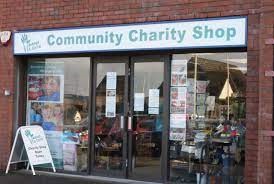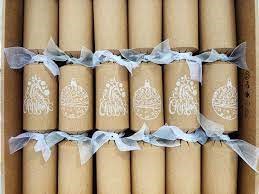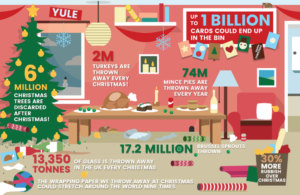Christmas. A Christian festival increasingly associated with waste and excess. Young reporter Abigail Leaper explores some of the ways we can become eco-conscious this festive period.
Christmas trees: real or fake?

Real trees are better because, if sourced sustainably, they can have a minimal impact on the environment. However it requires an eco-friendly disposal, which isn’t always possible.
Of course, a downside of an organic tree is that it can only be used once. Although fake trees can be used repeatedly, it should be noted that they use a lot of resources in production, and it takes a while to for them to decompose, especially if they are made out of plastic.
There is of course the option of wooden trees which can be reused and are preferable because of the speed at which they decompose.
If you were feeling particularly ambitious, you could plant your own tree in a pot and bring it in for Christmas each year. The Norfolk Island Pine is a tree that you can just keep indoors all year long and then decorate when the festive season is near.
But this topic is up to you as the debate continues on which is the best to do.
Socks? Again! Here’s what to do with unwanted presents

There are plenty of different ways to get rid of unwanted presents, before even looking at the bin.
Sell, charity, up-cycle, re-gift and if there is a gift receipt and tags. You can even return it to the shop it was bought from for money or another item.
Eco-friendly gifts

Christmas isn’t just about the receiving of course, it’s also about giving to others, and kindness.
Gifts don’t have to be vegan, plastic free and stamped by every environment management possible. They could be an experience, like a cinema pass or a trip to a theme park. It could be homemade consumables, vouchers, or home goods, things like candles or cutlery.
However, if you do want to start your gift receiver on the path to zero waste, a zero waste starter kit wouldn’t hurt. Just don’t get things that they already have as it defeats the point of zero waste.
DIY: Decorations
We have already talked Christmas trees, but what about the wreaths on doors? Or the Christmas crackers at the dinner table?
There are ways to bring the DIY spirit to your own wreath, which is better for the environment and much more fun. There are lots of websites on how to make your own wreath and here is one, but you can look for your own ideas. (You could even call on the expertise of our very own Mrs Sells!)
What about crackers? Well, there are a few options. No crackers. Ok, so before you explode, basic crackers from the supermarket are normally full of plastic, wrapped in plastic and made of plastic.
Of course, this isn’t the only option. You can make your own crackers, again, a quick Google will tell you all you need to know!
Or, possibly the more expensive option, green crackers. I don’t mean literally. The wrappers decompose, there is still a joke, a hat and a snapper, but it isn’t full of plastic, which makes them loads better for the environment.

But crackers, in my opinion, are probably one of the worst things to do with the environment. They are made to throw away.
And tinsel? That just sheds plastic. Tinsel is made from a non-recyclable plastic or film and sheds loads. Reuse the tinsel you have at home, before buying an eco alternative. But you can make your own or buy it online . It doesn’t have to be tinsel. It could be paper-chains or a reusable alternative.
But remember, it goes reduce (reduce the amount of plastic and single use products), reuse (reuse the products you have or obtain a reusable swap) and recycling comes last in the list. Did you know that in the UK only 45.7% of recycling is recycled?
Food and how NOT to waste it
This is probably one of the most important topics on here. Each year in the UK, about 7 million tons of food is wasted each year. Yes just the UK and yes, 7 million tons. 2 n turkeys, 5 million Christmas puddings and a whopping 74 million mince pies are thrown away in the UK each Christmas.

More than half of British people say that they spend more money on food than anything else, due to fear there will not be enough food to go around. One third of Brits admit that there is more waste at Christmas than any other time of year. There are several reasons for this.
Most shops and supermarkets have discounts and sales when it comes to the festive season and so many people over-buy and food that doesn’t get eaten is thrown away and wasted.
Another reason is to do with the fact that when Christmas dinner is served, it is a set portion and people have too much on their plate instead of choosing the right amount for them. So people get full and don’t eat all the food on their plate and in turn, it is wasted.

Lots of people also throw away leftovers. They can be heated up or turned into something new. Or even given to someone like a neighbor or family member who is elderly or just needs food.
End Note
So in the end is a zero waste Christmas really possible? The answer still remains unknown. But as long as you continue to consciously make an effort to be as green, that’s what counts.
By Abigail Leaper
The links used in this article are:
Zero waste Christmas: https://www.aconsideredlife.co.uk/2019/12/a-minimalist-zero-waste-christmas.html
Food and waste: https://www.respectfood.com/article/how-much-food-goes-to-waste-during-christmas-and-how-can-we-prevent-it/
Eco tinsel: https://www.countryliving.com/uk/homes-interiors/interiors/g25546553/plastic-free-alternatives-to-tinsel/